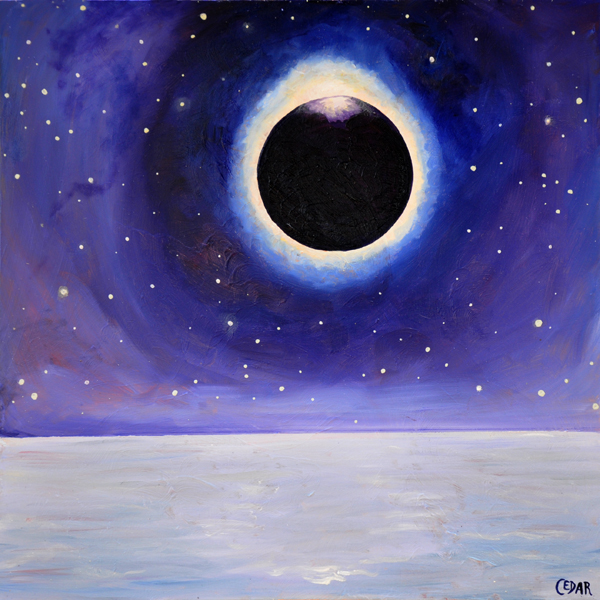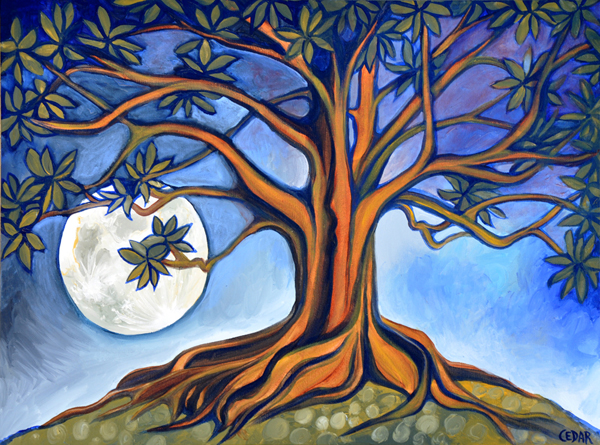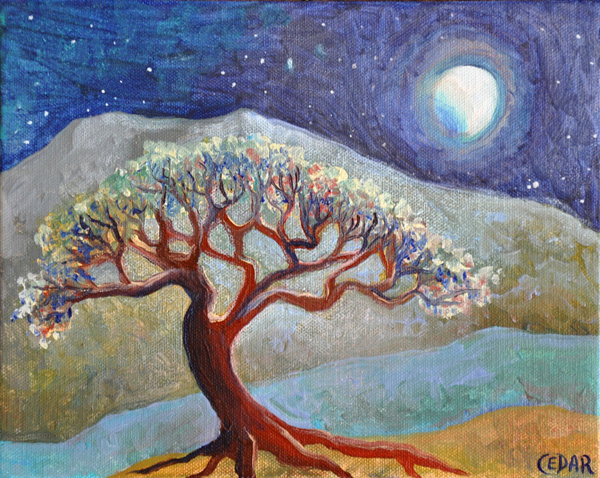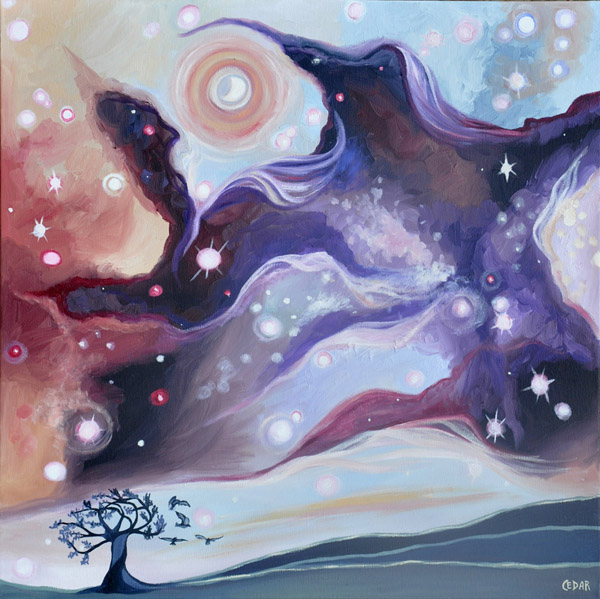Awhile back, someone left me a comment on one of my videos that made me bristle. In my video, I was explaining some of the ideas and processes that went into some of my paintings. The gist of the comment was that the person would rather not hear me talk about my work, and that instead of talking I should have just shown a slide show set to music so they wouldn’t have to be subjected to my annoying yakking while they were trying to enjoy the pretty pictures. After all, art should speak for itself.

My response was to suggest that if they weren’t interested in hearing my thoughts, they weren’t the intended viewer for that video, as the video was made specifically for people interested in hearing my thoughts. And that they could always mute the video then play their own music track while they watch, or perhaps just go view my paintings on my website where they can enjoy the art with no sound at all.
I’ve heard artists say, “Art speaks for itself,” as well as “After I’ve made the art, my job is done. It’s not my concern what happens after I put it out into the world.” I agree with this sentiment to an extent, as all artists must at some point relinquish control and make peace with whichever way their work happens to be received.

However, I think that an artist refusing to talk about their work is a cop-out, a sort of laziness. Of course it’s always easier to paint whatever you want, not put much thought into why you’re painting it or what it means, and put it out there for viewers to process as they will. But I think when you do things that way the art is not as purposeful, and when a viewer is genuinely interested in learning more about the artist’s thoughts, the artist won’t have the necessary practice to be able to articulate answers to questions.

One trend often made fun of in the art world–and I witnessed a lot of this especially as a young student artist–is when the artist feels compelled–or in the case of an art class, actually is required in order to fulfill an assignment–to answer questions about the meaning behind their art before they’ve clearly answered those questions their own mind.

The result: the notorious “BS” artist’s statement, stereotypically including the phrase “____ symbolizes man’s struggle against ____.” This sort of speech has also been used by insecure art viewers in an attempt to sound smart, grasping for whatever sounds “deep,” with the hope that whomever they’re trying to impress knows less about the art in question than they do. It’s funny! But it highlights how challenging it can be to think conceptually, visually, and verbally all at once.

However, the long and bumbling process of defining what’s important to you in your work and learning how to communicate it in words is a worthwhile one. It becomes easier with practice.
When you don’t make the effort to put your thoughts into words, you’re choosing to experience the process of your own work less deeply. An idea that never gets defined clearly has no chance to evolve into something bigger. Talking about your art can be difficult because for one thing, so much about painting is purely visual and simply hard to put words to, and for another, it forces you to really think about what you’re saying and why–to clearly define and examine your thought process behind the work.

It also takes bravery to talk about your work, because there’s always the niggling voice in the back of your mind telling you that other people will think you’re stupid, that your ideas are boring, that you aren’t good or interesting. Or even worse, you’ll discover that the intention behind your work didn’t translate at all, that you are so ineffective at visual communication that nobody got the message. Putting your thoughts into words makes you vulnerable to criticism.

What people may not understand is that when an artist is attempting to put words to the ideas behind the art, the listener is actually being included in the art-making process and witnessing a moment out of that artist’s evolution of his/her process. This is not for everyone, obviously. Only a select group out of your total audience is going to have any interest in hearing your thoughts about your work, and that’s okay. Not everyone needs that. Some prefer to just enjoy the art and inject their own meaning into it.

But, under the right circumstances, being able to talk about your art allows others to connect with it in ways they wouldn’t otherwise. And connecting to others is, in my opinion, one of the greatest pleasures of making art. If you’re interested in hearing me blather on a little bit, I discuss a few of the paintings in my Cosmic Dance series here:
What do you think? Do you like to hear artists’ thoughts about their own work, or do you prefer your experience of the art not to be influenced by that?
Hello , thank you for sharing your work and ideas in this blog and also in your videos on youtube. I like to hear you talk about your work process and your considerations on various subjects related to art . Regarding this issue , I think everyone has the freedom to write or talk about their work, whom ever wants to hear so be it if they do’nt why bother to make a bad comment about it? I think it’s just destructive criticism. It doesn’t bother me to know what the author says about his/her work , i think that it clarifies the motives that led him/her to perform the work and does’nt stop me from creating my own concept about the object in question . Freedom exists for both sides author and viewer. I agree that it is beneficial to write or verbalize but also risky because criticism is a constant in art . An author might consider rather not take that risk , or simply find that the opinion of others is not so important , or his/her reasons are too personal to be exposed , it’s a personal option and so I think there is no obligation in doing things one way or another. As for me I will continue to hear and read what you write and I thank you for doing so.
I love hearing/reading about your work, the process or anything that you want to share, not only is it educational but makes looking at your work when you are not talking or writing about it…more personal and enjoyable for me. 🙂
“You could be the juiciest peach and there will be someone who doesn’t like peaches” I saw this quote on Pinterest, and I believe it applies here.
You can’t please everyone.
The comment you received was not constructive criticism, but just mean spirited.
When you become pro and make a living off your art and reach a level of personal success, the trolls come out. I’d take it as evidence that you are a success 🙂
Personally, I LOVE reading about the artists’ reflections on why certain colors or symbols were used. Art making of any kind is highly autobiographical – there’s a slice of the artist’s soul in every creation. Presenting say a painting, leaves it open for the viewers interpretation, but giving the viewer an explanation as to how, why the elements were chosen, it’s like giving a viewer a peek into your journal entry… It’s so much more intimate, and in doing so you’re forging a closer bond with your audience, and being more relatable, honest and raw in your work.
You are an inspiration … Do not let the trolls get to you!
Maybe that person was a blocked creative. Hard to know why someone would say something like that. Almost like they wanted you to stifle yourself. It takes guts to put your ideas out there the way you do.
Hi Cedar,
I’m always interested in hearing what an artists says about their work and what goes into making their artwork, why they chose the materials they did, etc. I don’t always understand their meaning, but that’s okay too.
Thanks for sharing,
Carmen
Hi Cedar,
I think it’s very important for an artist to be able to articulate his or her work; why they do it, what it’s about, as well as the more technical aspects of it’s creation. Giving a banal response when asked about your art conveys lack of passion and direction. Furthermore, the idea that art speaks for itself is, I think, one of the biggest myths in the art world. The considerable literature in the fields of art history and criticism clearly belie this myth.
Of course, all art must necessarily speak for itself to the extent that it exists as a physical, visual object and that, as such, demands some response, even if only at the most superficial of levels. I agree with you that once our art is “out there”, we have no control over what others may think about it’s purpose and creation. And indeed, this is part of the wonder of art, namely it’s ability to be experienced on a myriad of levels and speak to people of widely divergent backgrounds and life experiences.
With respect to my own situation, I found that it was vitally important to become comfortable talking about my work. Once I decided to do this, I started by actually thinking about both myself and my art. Why do I do what I do? What motivates me? What informs my art? What message(s) do I want to convey with it? Once I had answered these questions to my satisfaction, I wrote them down and developed a succinct statement, which allows me to speak about my art confidently, intelligently, and passionately. Additionally, it serves as my elevator speech, the length and detail of which I can tweak depending on who I am talking to and how much time I have.
The greatest benefit of this exercise has been to myself. Once I had organized my thoughts and put them into words, I found that it gave greater purpose and depth to my art making process. I felt more excited about my art and more driven to produce it. It has a better chance to, as you say, evolve into something bigger.
Great topic Cedar. Hope to see you at Kim’s opening next month.
~Daniel
Cedar- I just discovered you on YouTube as I attempt to start a new career after 30 years in the insurance business. I find your work and your thoughts compelling. I like to know the process that you go through that culminate in such rich images. I wrote down some of your suggestions on pricing, placing limits on yourself, etc. For myself, keep on yakking- it’s inspiring!